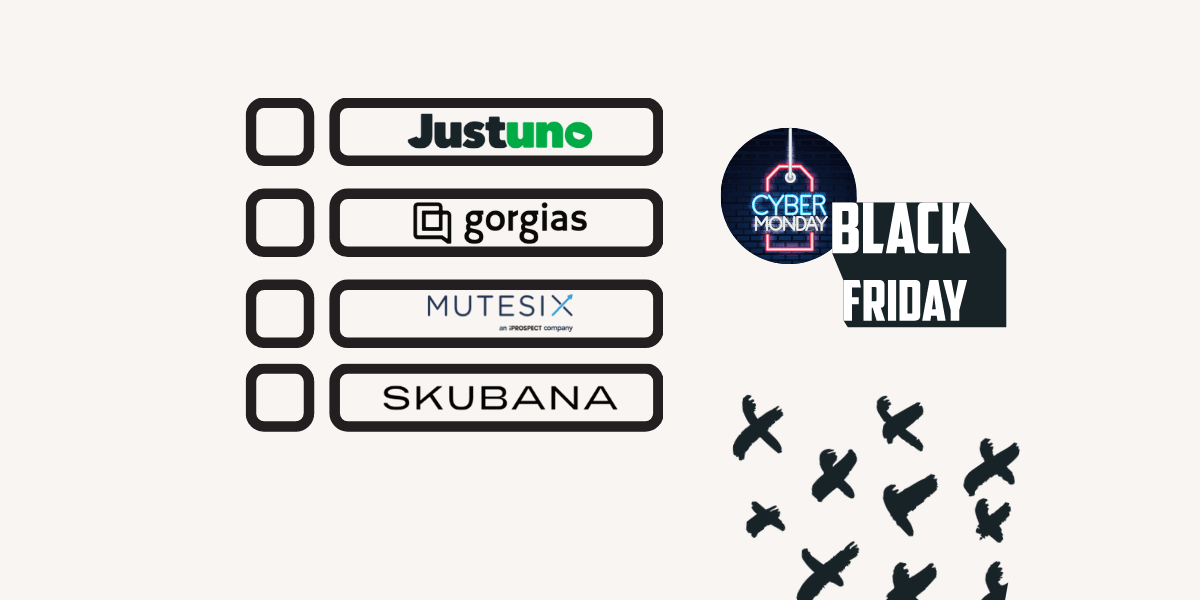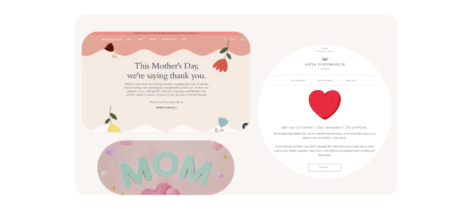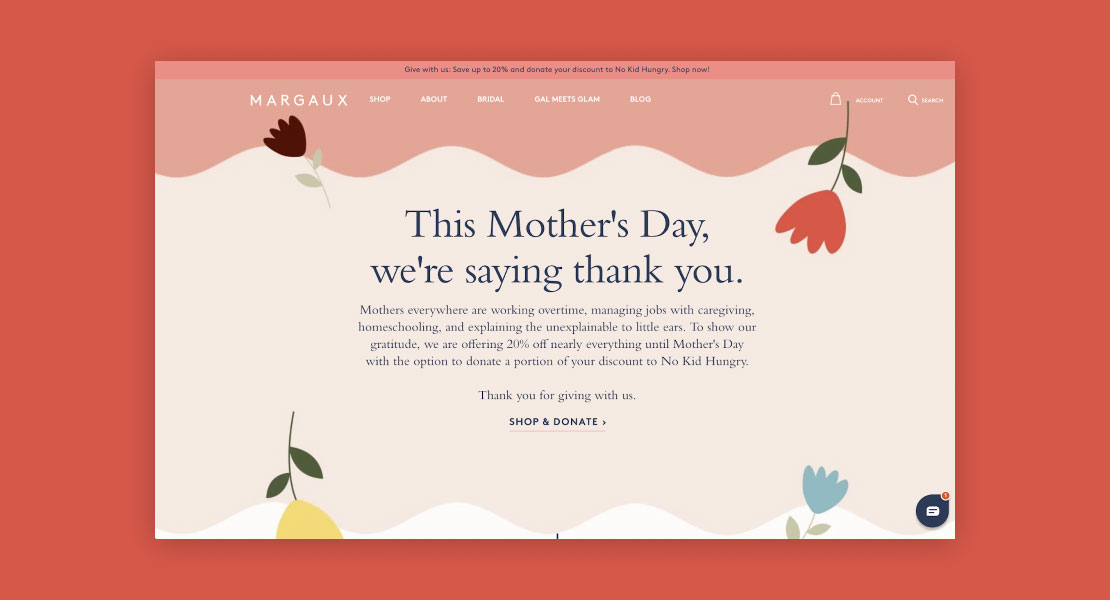With the single largest online shopping holiday of the year behind us, it’s crucial to review how your brand did. What products sold the best? What promotions were most successful? What channel drove the most site visitors or conversions? What was your AOV and how can you improve that further? What data should you be looking at in order to optimize Q1 of 2022 and beyond?
We asked some of our favorite partners – Skubana, MuteSix, and Gorgias – to give their perspective on BFCM 2021 and what brands should review as we go into a new year.
What Are The Most Important Metrics to Look at When Reviewing BFCM Performance?
Skubana: From our perspective, your Cart Abandonment Rate (CAR) is an extremely important metric to review. We saw an increase in cart abandonment industry-wide this BFCM which was the result of a multitude of factors. From shipping costs to stock-outs, and shipping delays customers abandoned their carts this year at a much higher rate than in 2020. We advise reviewing your site to see which factors could have caused potential customers to leave to see where opportunities lie and how to combat this in the future.
Another important metric to review is your Average Order Value (AOV). Did you take advantage of bundling and kitting in order to increase this number? This is a great way to drive more revenue and offset acquisition costs while ultimately providing more value for your customers.
Justuno: Review the onsite pop-up campaigns you set up to see overall revenue-driven, engagement rates (CTA click, submission, or viewed for >7 seconds), and actual conversions. Remember for Justuno the last pop-up seen before a conversion gets the attribution, which means site-wide messaging like banners may reflect lower numbers than you wanted. Time on site, pages visited, and conversion rate will give you a more big-picture view of your BFCM performance but deep dive into analytics like most abandoned URLs, abandoned cart AOV, etc. to help plan for inventory clearance sales in January and overall see where in the onsite experience you’re missing the mark with customers.
Also if your BFCM numbers aren’t what you wanted remember the extended shopping season that has had consumers starting to buy gifts as early as September! Look at the season as a whole first to see if your numbers are really down or simply more spread out. BFCM is a huge weekend for retailers but as we see it grow longer due to external factors it’s important to maintain perspective for when/how our sales come in and its impact on data analysis.
MuteSix: Acquisition metrics are key. Black Friday / Cyber Monday is a time when you can expect existing customers to pounce on holiday promotions and spend more ahead of the holidays. They’re low-hanging fruit in the grand scheme of things. Turn your attention, instead, to the newly acquired customers who found you during this highly competitive shopping period, learned about your offerings, and chose to purchase from you – that’s the ultimate testament to the effectiveness of your marketing efforts.
Be sure to track new customers vs. existing customers, how much you spent to acquire them, and where you converted them. In Q1, you’ll then need to look at retention metrics to ensure they’re continuing to buy from you so that your marketing efforts from Black Friday / Cyber Monday truly pay off.
Gorgias: We recommend looking at three key metrics in regard to your customer service & experience:
- First response time (how long did it take you to first respond to support tickets)
- Resolution time (how long did it take you to resolve support tickets)
- CSAT (how did your CSAT during BFCM compare to normal times of the year?)
- CSAT is the satisfaction score calculated on the basis of a survey filled with the customers stating how satisfied they are with your service.
These metrics are all an important measure of how easily your customers were able to get the answers they needed to purchase from you. If these are substantially longer than previous years, there may be some areas of opportunity for automation and flows to ease the burden on your CS team and get shoppers the answers they’re looking for faster.
What’s Something Interesting/Surprising You Saw During BFCM?
Skubana: We saw Cyber Monday turn into cyber month so customers could get their products in time. Shipping requirements such as Amazon telling sellers to have their inventory in by mid-November encouraged sellers to start their sales earlier in the year. On the other side of BFCM, we saw many companies extending their offers. Overall the length of sales this year was dragged out benefiting consumers who want to shop from a variety of places.
MuteSix: A new trend of earlier consumer purchasing behavior started in 2020, but was significantly more apparent this year, largely due to earlier, more aggressive promotions, paired with looming supply chain issues and shipping delays.
With a number of MuteSix’s clients, we also saw first-hand how TikTok feeds other platforms to bring less-expensive traffic, increase targeting capabilities, boost remarketing efforts, and most importantly get consumers to their websites to complete purchases.
On the remarketing front, we continued to see the success of consolidated ad structures. Because of iOS 14, remarketing audiences have been pillaged, detrimentally affecting remarketing performance. During Black Friday / Cyber Monday, which is so heavily focused on remarketing, we found that broad remarketing structures across all the paid social platforms continued to deliver better results than a segmented approach.
Justuno: This BFCM we saw a continued trend of shopping local, our clients actually had higher overall conversion rates on Small Business Saturday (4.2%) than they did on Cyber Monday (4.15%)! This is likely a reflection of the conscious effort by the 25% of US consumers who said they’d be looking to shop on SBS.
Another interesting trend is the rise of the corner pop-up, we’re seeing more and more websites use this location to show more than a banner would but not interrupt shopper’s experiences as a center pop-up would. Corner promotions had an average 15.24% conversion rate over Cyber weekend nearly double the rate of other placements.
Gorgias: We saw a 3x increase in the volume of product orders but only a 1.4x increase in support tickets. This means that brands did a better job in 2021 than 2020 in making their product information, return processes, and FAQs clearer and more accessible to visitors coming onto their site.
What Insights Should Brands Use to Finish Out 2021 Strong?
Skubana: Look at your inventory levels across all channels. See which stock is leftover or sold less than you predicted. Find creative ways to bundle these items in order to get rid of old stock. We’ve seen tactics like “stocking stuffers”, utilization of Shopify’s one-click upsell post-purchase, and Skubana’s order bots that add free items to each order to help customers get rid of their seasonal stock. Thus, you can begin 2022 with more space in your warehouses for post-holiday stock.
MuteSix: To finish the year off strong, create a sense of urgency through the December 17 shipping cutoff – whether it be through your paid social promos or messaging. Then, from the shipping cutoff onward, establish a strong communication strategy to incentivize shoppers to continue purchasing by promoting digital gift cards, which will arrive on time for the holiday.
Justuno: Don’t freak out if your numbers aren’t what you want. There is still time to close out the year strong with targeted onsite campaigns for procrastinators like pushing gift cards that are guaranteed to arrive on time, geo-targeted banners based on shipping cut-offs, or digital alternatives to gift in the interim while their packages are on the way.
Gorgias: Focus on retention to keep those hard-earned BFCM/holiday customers. You can keep them by ensuring you deliver a seamless/fast & memorable customer experience over the holidays. Customers know you are swamped, so if you can STILL deliver at this time of the year, it says a lot about your business.
What are Some Next Steps to Set Up Q1 Based On 2021 Performance YTD?
Skubana: Look at trends from the past couple of years and expect 2022 to look similar in the way that predictability is still uncertain. Skubana has forecasting tools such as Automatic Purchase Orders to help guide smart purchasing decisions. Look at your most profitable products to see if you need to shift your purchasing trends. It’s also a good time to explore growing your tech stack and warehouse reach.
How much time did you lose to manual work? Increasing automation that works for you can expedite overall business growth. You can also evaluate expediting your customers’ shipping by adding an additional warehouse or two. Skubana and 3PL Centrals’ seamless integration makes fulfillment expansion easy. Q1 is always the best time to get started on exploring all of this!
Justuno: Start building out your campaigns for 2022 now, take into account what your Q1 goals are and where you can make the most impact onsite. If you’re looking to improve personalization and see a boost to your order value, implementing intelligent product recommendations would be a full-funnel strategy from best sellers on the home page to in-cart cross-sells based on cart contents and everything in between. If you’re looking to expand your lead capture to additional channels like SMS or Instagram and TikTok handles, create two-step lead captures to grow these channels alongside email for new visitors and on their own for returning customers. Q1 is the best time to lay the groundwork for new channels and onsite optimization for the whole year.
MuteSix: Focus heavily on retargeting your newly acquired customers and converting them into repeat shoppers in 2022. Q1 is a great time to establish brand equity, whether it be through compelling content and messaging on paid social or elsewhere, like email. Use this time to really position your brand as the premium choice in your sector so that newly acquired and existing customers alike want to continue shopping with you long after the holiday promos expire.
Gorgias: Focus on where your biggest areas for improvement are around customer support & customer experience. Figure out what can be automated, what channels you need to start engaging with customers on (e.g., IG, FB, live chat, etc), and figure out how to eliminate more post-purchase inquiries (by making info more accessible) so your teams can focus more on pre-sale engagement (e.g., live chat, FB DM’s)
Final Thoughts
If you’re interested in learning more about Skubana, Gorgias, or MuteSix, let us know at partners@justuno.com and we’d be happy to connect you (even if you aren’t a current Justuno customer!)
Additionally, please take advantage of these special offers provided by Gorgias and MuteSix:
Gorgias: Get 2nd and 3rd month free by paying for the first month by emailing chris@gorgias.com.
MuteSix: 2022 is the year to diversify your Paid Media Mix so as to maximize reach and ROI. Get a free marketing consultation from the omnichannel digital marketing experts at MuteSix today.



